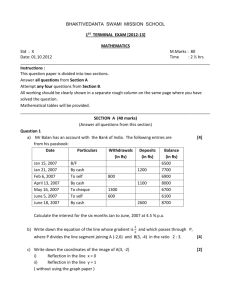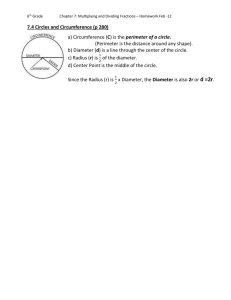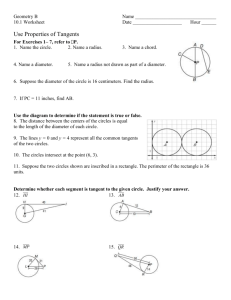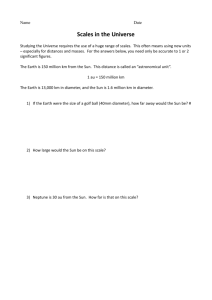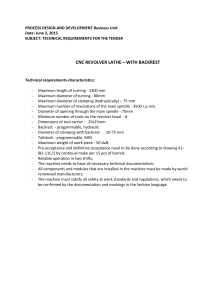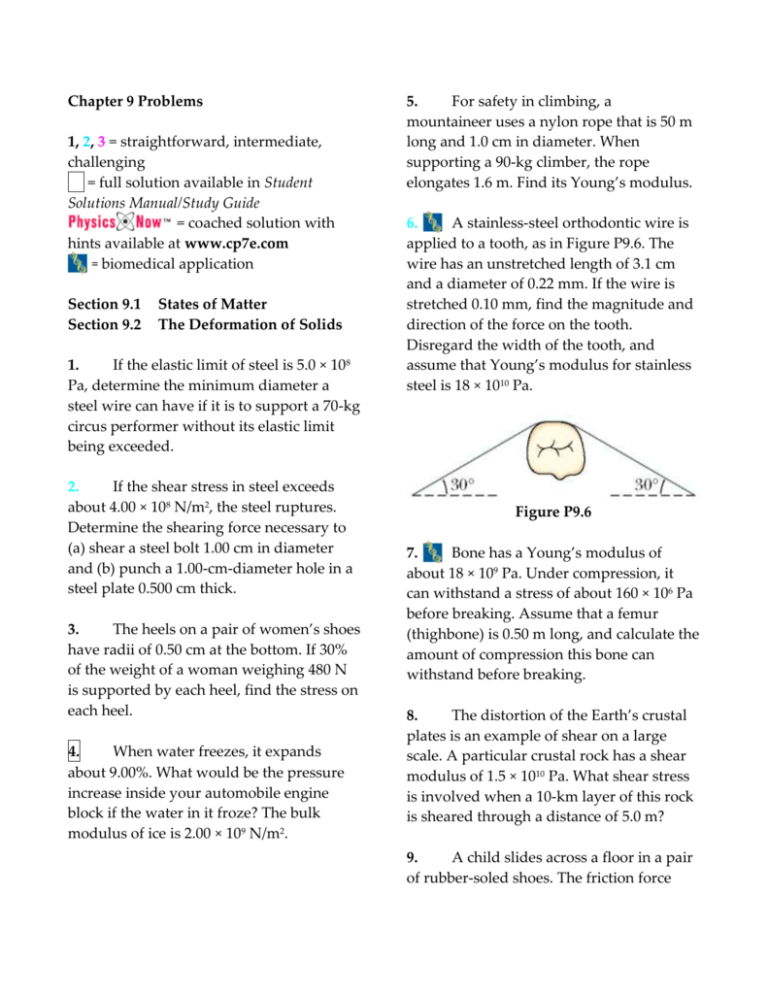
Chapter 9 Problems
1, 2, 3 = straightforward, intermediate,
challenging
= full solution available in Student
Solutions Manual/Study Guide
= coached solution with
hints available at www.cp7e.com
= biomedical application
Section 9.1
Section 9.2
States of Matter
The Deformation of Solids
1.
If the elastic limit of steel is 5.0 × 108
Pa, determine the minimum diameter a
steel wire can have if it is to support a 70-kg
circus performer without its elastic limit
being exceeded.
2.
If the shear stress in steel exceeds
about 4.00 × 108 N/m2, the steel ruptures.
Determine the shearing force necessary to
(a) shear a steel bolt 1.00 cm in diameter
and (b) punch a 1.00-cm-diameter hole in a
steel plate 0.500 cm thick.
3.
The heels on a pair of women’s shoes
have radii of 0.50 cm at the bottom. If 30%
of the weight of a woman weighing 480 N
is supported by each heel, find the stress on
each heel.
4.
When water freezes, it expands
about 9.00%. What would be the pressure
increase inside your automobile engine
block if the water in it froze? The bulk
modulus of ice is 2.00 × 109 N/m2.
5.
For safety in climbing, a
mountaineer uses a nylon rope that is 50 m
long and 1.0 cm in diameter. When
supporting a 90-kg climber, the rope
elongates 1.6 m. Find its Young’s modulus.
6.
A stainless-steel orthodontic wire is
applied to a tooth, as in Figure P9.6. The
wire has an unstretched length of 3.1 cm
and a diameter of 0.22 mm. If the wire is
stretched 0.10 mm, find the magnitude and
direction of the force on the tooth.
Disregard the width of the tooth, and
assume that Young’s modulus for stainless
steel is 18 × 1010 Pa.
Figure P9.6
7.
Bone has a Young’s modulus of
about 18 × 109 Pa. Under compression, it
can withstand a stress of about 160 × 106 Pa
before breaking. Assume that a femur
(thighbone) is 0.50 m long, and calculate the
amount of compression this bone can
withstand before breaking.
8.
The distortion of the Earth’s crustal
plates is an example of shear on a large
scale. A particular crustal rock has a shear
modulus of 1.5 × 1010 Pa. What shear stress
is involved when a 10-km layer of this rock
is sheared through a distance of 5.0 m?
9.
A child slides across a floor in a pair
of rubber-soled shoes. The friction force
acting on each foot is 20 N, the footprint
area of each foot is 14 cm2, and the
thickness of the soles is 5.0 mm. Find the
horizontal distance traveled by the sheared
face of the sole. The shear modulus of the
rubber is 3.0 × 106 Pa.
10.
A high-speed lifting mechanism
supports an 800-kg object with a steel cable
that is 25.0 m long and 4.00 cm2 in crosssectional area. (a) Determine the elongation
of the cable. (b) By what additional amount
does the cable increase in length if the
object is accelerated upwards at a rate of 3.0
m/s2? (c) What is the greatest mass that can
be accelerated upwards at 3.0 m/s2 if the
stress in the cable is not to exceed the elastic
limit of the cable, which is 2.2 × 108 Pa?
11.
Determine the elongation of the rod
in Figure P9.11 if it is under a tension of 5.8
× 103 N.
Section 9.3
Density and Pressure
13.
A 50.0-kg ballet dancer stands on her
toes during a performance with four square
inches (26.0 cm2) in contact with the floor.
What is the pressure exerted by the floor
over the area of contact (a) if the dancer is
stationary and (b) if the dancer is leaping
upwards with an acceleration of 4.00 m/s2?
14.
The four tires of an automobile are
inflated to a gauge pressure of 2.0 × 105 Pa.
Each tire has an area of 0.024 m2 in contact
with the ground. Determine the weight of
the automobile.
15.
Air is trapped above liquid ethyl
alcohol in a rigid container, as shown in
Figure P9.15. If the air pressure above the
liquid is 1.10 atm, determine the pressure
inside a bubble 4.0 m below the surface of
the liquid.
Figure P9.11
12.
The total cross-sectional area of the
load-bearing calcified portion of the two
forearm bones (radius and ulna) is
approximately 2.4 cm2. During a car crash,
the forearm is slammed against the
dashboard. The arm comes to rest from an
initial speed of 80 km/h in 5.0 ms. If the arm
has an effective mass of 3.0 kg and bone
material can withstand a maximum
compressional stress of 16 × 107 Pa, is the
arm likely to withstand the crash?
Figure P9.15
16.
A 70-kg man in a 5.0-kg chair tilts
back so that all the weight is balanced on
two legs of the chair. Assume that each leg
makes contact with the floor over a circular
area with a radius of 1.0 cm, and find the
pressure exerted by each leg on the floor.
17.
If 1.0 m3 of concrete weighs 5.0 × 104
N, what is the height of the tallest
cylindrical concrete pillar that will not
collapse under its own weight? The
compression strength of concrete (the
maximum pressure that can be exerted on
the base of the structure) is 1.7 × 107 Pa.
Section 9.3
Section 9.4
Depth
Section 9.5
Density and Pressure
Variation of Pressure with
Pressure Measurements
Figure P9.19
18.
The deepest point in the ocean is in
the Mariana Trench, about 11 km deep. The
pressure at the ocean floor is huge, about
1.13 × 108 N/m2. (a) Calculate the change in
volume of 1.00 m3 of water carried from the
surface to the bottom of the Pacific. (b) The
density of water at the surface is 1.03 × 103
kg/m3. Find its density at the bottom. (c) Is
it a good approximation to think of water
as incompressible?
20.
(a) A very powerful vacuum cleaner
has a hose 2.86 cm in diameter. With no
nozzle on the hose, what is the weight of
the heaviest brick it can lift? (b) A very
powerful octopus uses one sucker, of
diameter 2.86 cm, on each of the two shells
of a clam, in an attempt to pull the shells
apart. Find the greatest force the octopus
can exert in salt water 32.3 m deep.
19.
A collapsible plastic bag (Figure
P9.19) contains a glucose solution. If the
average gauge pressure in the vein is 1.33 ×
103 Pa, what must be the minimum height h
of the bag in order to infuse glucose into the
vein? Assume that the specific gravity of
the solution is 1.02.
21.
For the cellar of a new house, a hole
is dug in the ground, with vertical sides
going down 2.40 m. A concrete foundation
wall is built all the way across the 9.60-m
width of the excavation. The foundation
wall is 0.183 m away from the front of the
cellar hole. During a rainstorm, drainage
from the street fills up the space in front of
the concrete wall, but not the cellar behind
the wall. The water does not soak into the
clay soil. Find the force the water exerts on
the foundation wall. For comparison, the
weight of the water is 2.40 m × 9.60 m ×
0.183 m × 1 000 kg/m3 × 9.80 m/s2 = 41.3 kN.
determine the force F necessary to support
the 500-lb weight.
22.
Blaise Pascal duplicated Torricelli’s
barometer using a red Bordeaux wine of
density 984 kg/m3 as the working liquid
(Fig. P9.22). What was the height h of the
wine column for normal atmospheric
pressure? Would you expect the vacuum
above the column to be as good as for
mercury?
Figure P9.24
Figure P9.22
25.
Figure P9.25 shows the essential
parts of a hydraulic brake system. The area
of the piston in the master cylinder is 6.4
cm2, and that of the piston in the brake
cylinder is 1.8 cm2. The coefficient of
friction between shoe and wheel drum is
0.50. If the wheel has a radius of 34 cm,
determine the frictional torque about the
axle when a force of 44 N is exerted on the
brake pedal.
23.
A container is filled
to a depth of 20.0 cm with water. On top of
the water floats a 30.0-cm-thick layer of oil
with specific gravity 0.700. What is the
absolute pressure at the bottom of the
container?
24.
Piston
in Figure P9.24 has a
diameter of 0.25 in.; piston
has a
diameter of 1.5 in. In the absence of friction,
Figure P9.25
Section 9.6 Buoyant Forces and
Archimedes’ Principle
26.
A frog in a hemispherical pod finds
that he just floats without sinking in a fluid
of density 1.35 g/cm3. If the pod has a
radius of 6.00 cm and negligible mass, what
is the mass of the frog? (See Fig. P9.26.)
Figure P9.26
27.
A small ferryboat is 4.00 m wide and
6.00 m long. When a loaded truck pulls
onto it, the boat sinks an additional 4.00 cm
into the river. What is the weight of the
truck?
where ρg is the density of granite (2.8 × 103
kg/m3), ρp is the density of peridotite (3.3 ×
103 kg/m3), t is the thickness of a continent,
and d is the depth to which a continent
floats in the peridotite. (b) If a continent
sinks 5.0 km into the peridotite layer (this
surface may be thought of as the ocean
floor), what is the thickness of the
continent?
30.
A 10.0-kg block of metal is
suspended from a scale and immersed in
water, as in Figure P9.30. The dimensions of
the block are 12.0 cm × 10.0 cm × 10.0 cm.
The 12.0-cm dimension is vertical, and the
top of the block is 5.00 cm below the surface
of the water. (a) What are the forces exerted
by the water on the top and bottom of the
block? (Take P0 = 1.013 0 × 105 N/m2.) (b)
What is the reading of the spring scale? (c)
Show that the buoyant force equals the
difference between the forces at the top and
bottom of the block.
28.
The density of ice is 920 kg/m3, and
that of sea water is 1 030 kg/m3. What
fraction of the total volume of an iceberg is
exposed?
29.
As a first approximation, the Earth’s
continents may be thought of as granite
blocks floating in a denser rock (called
peridotite) in the same way that ice floats in
water. (a) Show that a formula describing
this phenomenon is
ρgt = ρpd
Figure P9.30
31.
A bathysphere used for deep sea
exploration has a radius of 1.50 m and a
mass of 1.20 × 104 kg. In order to dive, the
sphere takes on mass in the form of sea
water. Determine the mass the bathysphere
must take on so that it can descend at a
constant speed of 1.20 m/s when the
resistive force on it is 1 100 N upward. The
density of sea water is 1.03 × 103 kg/m3.
32.
The United States possesses the eight
largest warships in the world—aircraft
carriers of the Nimitz class—and is building
one more. Suppose that, at a location where
g = 9.78 m/s2, one of the ships bobs up to
float 11.0 cm higher in the water when 50
fighters take off from it in 25 minutes.
Bristling with bombs and missiles, each
plane has an average mass of 29 000 kg.
Find the horizontal area enclosed by the
waterline of the $4-billion ship. By
comparison, its flight deck has area of 18
000 m2. Below decks are passageways
hundreds of meters long, so narrow that
two large men cannot pass each other.
33.
An empty rubber balloon has a mass
of 0.012 0 kg. The balloon is filled with
helium at a density of 0.181 kg/m3. At this
density, the balloon has a radius of 0.500 m.
If the filled balloon is fastened to a vertical
line, what is the tension in the line?
34.
A light spring of force constant k =
160 N/m rests vertically on the bottom of a
large beaker of water (Fig. P9.34a). A 5.00kg block of wood (density = 650 kg/m3) is
connected to the spring, and the block–
spring system is allowed to come to static
equilibrium (Fig. P9.34b). What is the
elongation ΔL of the spring?
Figure P9.34
35.
A sample of an unknown material
appears to weigh 300 N in air and 200 N
when immersed in alcohol of specific
gravity 0.700. What are (a) the volume and
(b) the density of the material?
36.
An object weighing 300 N in air is
immersed in water after being tied to a
string connected to a balance. The scale
now reads 265 N. Immersed in oil, the
object appears to weigh 275 N. Find (a) the
density of the object and (b) the density of
the oil.
37.
A thin spherical shell of mass 0.400
kg and diameter 0.200 m is filled with
alcohol (ρ = 806 kg/m3). It is then released
from rest at the bottom of a pool of water.
Find the acceleration of the alcohol-filled
shell as it starts to rise toward the surface of
the water.
38.
A rectangular air mattress is 2.0 m
long, 0.50 m wide, and 0.08 m thick. If it has
a mass of 2.0 kg, what additional mass can
it support in water?
39.
A 1.00-kg beaker
containing 2.00 kg of oil (density = 916
kg/m3) rests on a scale. A 2.00-kg block of
iron is suspended from a spring scale and is
completely submerged in the oil (Fig.
P9.39). Find the equilibrium readings of
both scales.
41.
(a) Calculate the mass flow rate (in
grams per second) of blood (ρ = 1.0 g/cm3)
in an aorta with a cross-sectional area of 2.0
cm2 if the flow speed is 40 cm/s. (b) Assume
that the aorta branches to form a large
number of capillaries with a combined
cross-sectional area of 3.0 × 103 cm2. What is
the flow speed in the capillaries?
42.
A liquid (ρ = 1.65 g/cm3) flows
through two horizontal sections of tubing
joined end to end. In the first section, the
cross-sectional area is 10.0 cm2, the flow
speed is 275 cm/s, and the pressure is 1.20 ×
105 Pa. In the second section, the crosssectional area is 2.50 cm2. Calculate the
smaller section’s (a) flow speed and (b)
pressure.
Figure P9.39
Section 9.7
Section 9.8
Dynamics
Fluids in Motion
Other Applications of Fluid
40.
Water is pumped into a storage tank
from a well delivering 20.0 gallons of water
in 30.0 seconds through a pipe of 1.00-in.2
cross-sectional area. What is the average
velocity of the water in the pipe as the
water is pumped from the well?
43.
A hypodermic syringe contains a
medicine with the density of water (Fig.
P9.43). The barrel of the syringe has a crosssectional area of 2.50 × 10–5 m2. In the
absence of a force on the plunger, the
pressure everywhere is 1.00 atm. A force F
of magnitude 2.00 N is exerted on the
plunger, making medicine squirt from the
needle. Determine the medicine’s flow
speed through the needle. Assume that the
pressure in the needle remains equal to 1.00
atm and that the syringe is horizontal.
Figure P9.43
44.
When a person inhales, air moves
down the bronchus (windpipe) at 15 cm/s.
The average flow speed of the air doubles
through a constriction in the bronchus.
Assuming incompressible flow, determine
the pressure drop in the constriction.
right at a rate of 1.80 × 10–4 m3/s. Determine
the inside diameter of the constriction.
45.
A jet of water squirts
out horizontally from a hole near the
bottom of the tank shown in Figure P9.45. If
the hole has a diameter of 3.50 mm, what is
the height h of the water level in the tank?
Figure P9.47
Figure P9.45
46.
A large storage tank, open to the
atmosphere at the top and filled with water,
develops a small hole in its side at a point
16.0 m below the water level. If the rate of
flow from the leak is 2.50 × 10–3 m3/min,
determine (a) the speed at which the water
leaves the hole and (b) the diameter of the
hole.
47.
The inside diameters of the larger
portions of the horizontal pipe depicted in
Figure P9.47 are 2.50 cm. Water flows to the
48.
Water is pumped through a pipe of
diameter 15.0 cm from the Colorado River
up to Grand Canyon Village, on the rim of
the canyon. The river is at 564 m elevation
and the village is at 2 096 m. (a) At what
minimum pressure must the water be
pumped to arrive at the village? (b) If 4 500
m3 are pumped per day, what is the speed
of the water in the pipe? (c) What
additional pressure is necessary to deliver
this flow? [Note: You may assume that the
free-fall acceleration and the density of air
are constant over the given range of
elevations.]
49.
Old Faithful geyser in Yellowstone
Park erupts at approximately 1-hour
intervals, and the height of the fountain
reaches 40.0 m. (a) Consider the rising
stream as a series of separate drops.
Analyze the free-fall motion of one of the
drops to determine the speed at which the
water leaves the ground. (b) Treat the rising
stream as an ideal fluid in streamline flow.
Use Bernoulli’s equation to determine the
speed of the water as it leaves ground level.
(c) What is the pressure (above atmospheric
pressure) in the heated underground
chamber 175 m below the vent? You may
assume that the chamber is large compared
with the geyser vent.
50.
An airplane is cruising at an altitude
of 10 km. The pressure outside the craft is
0.287 atm; within the passenger
compartment, the pressure is 1.00 atm and
the temperature is 20°C. The density of air
is 1.20 kg/m3 at 20°C and 1 atm of pressure.
A small leak forms in one of the window
seals in the passenger compartment. Model
the air as an ideal fluid to find the speed of
the stream of air flowing through the leak.
51.
A siphon is a device that allows a
fluid to seemingly defy gravity (Fig. P9.51).
The flow must be initiated by a partial
vacuum in the tube, as in a drinking straw.
(a) Show that the speed at which the water
emerges from the siphon is given by
v 2 gh . (b) For what values of y will the
Section 9.9 Surface Tension, Capillary
Action, and Viscous Fluid Flow
52.
In order to lift a wire ring of radius
1.75 cm from the surface of a container of
blood plasma, a vertical force of 1.61 × 10–2
N greater than the weight of the ring is
required. Calculate the surface tension of
blood plasma from this information.
53.
A square metal sheet 3.0 cm on a
side and of negligible thickness is attached
to a balance and inserted into a container of
fluid. The contact angle is found to be zero,
as shown in Figure P9.53a, and the balance
to which the metal sheet is attached reads
0.40 N. A thin veneer of oil is then spread
over the sheet, and the contact angle
becomes 180°, as shown in Figure P9.53b.
The balance now reads 0.39 N. What is the
surface tension of the fluid?
siphon work?
Figure P9.51
Figure P9.53
54.
Whole blood has a surface tension of
0.058 N/m and a density of 1 050 kg/m3. To
what height can whole blood rise in a
capillary blood vessel that has a radius of
2.0 × 10–6 m if the contact angle is zero?
55.
A certain fluid has a density of 1 080
3
kg/m and is observed to rise to a height of
2.1 cm in a 1.0-mm-diameter tube. The
contact angle between the wall and the
fluid is zero. Calculate the surface tension
of the fluid.
56.
A staining solution used in a
microbiology laboratory has a surface
tension of 0.088 N/m and a density 1.035
times the density of water. What must be
the diameter of a capillary tube so that this
solution will rise to a height of 5 cm?
(Assume a contact angle of zero.)
57.
The block of ice (temperature 0°C)
shown in Figure P9.57 is drawn over a level
surface lubricated by a layer of water 0.10
mm thick. Determine the magnitude of the
force F needed to pull the block with a
constant speed of 0.50 m/s. At 0°C, the
viscosity of water has the value η = 1.79 ×
10–3 N ∙ s / m2.
58.
A thin 1.5-mm coating of glycerine
has been placed between two microscope
slides of width 1.0 cm and length 4.0 cm.
Find the force required to pull one of the
microscope slides at a constant speed of
0.30 m/s relative to the other slide.
59.
A straight horizontal pipe with a
diameter of 1.0 cm and a length of 50 m
carries oil with a coefficient of viscosity of
0.12 N ∙ s / m2. At the output of the pipe, the
flow rate is 8.6 × 10–5 m3/s and the pressure
is 1.0 atm. Find the gauge pressure at the
pipe input.
60.
The pulmonary artery, which
connects the heart to the lungs, has an inner
radius of 2.6 mm and is 8.4 cm long. If the
pressure drop between the heart and lungs
is 400 Pa, what is the average speed of
blood in the pulmonary artery?
61.
Spherical particles of a protein of
density 1.8 g/cm3 are shaken up in a
solution of 20°C water. The solution is
allowed to stand for 1.0 h. If the depth of
water in the tube is 5.0 cm, find the radius
of the largest particles that remain in
solution at the end of the hour.
62.
A hypodermic needle is 3.0 cm in
length and 0.30 mm in diameter. What
excess pressure is required along the needle
so that the flow rate of water through it will
be 1 g/s? (Use 1.0 × 10–3 Pa ∙ s as the
viscosity of water.)
Figure P9.57
63.
What diameter needle should be
used to inject a volume of 500 cm3 of a
solution into a patient in 30 min? Assume
that the length of the needle is 2.5 cm and
that the solution is elevated 1.0 m above the
point of injection. Furthermore, assume the
viscosity and density of the solution are
those of pure water, and assume that the
pressure inside the vein is atmospheric.
64.
Water is forced out of a fire
extinguisher by air pressure, as shown in
Figure P9.64. What gauge air pressure in
the tank (above atmospheric pressure) is
required for the water to have a jet speed of
30.0 m/s when the water level in the tank is
0.500 m below the nozzle?
67.
Sucrose is allowed to diffuse along a
10-cm length of tubing filled with water.
The tube is 6.0 cm2 in cross-sectional area.
The diffusion coefficient is equal to 5.0 ×
10–10 m2/s, and 8.0 × 10–14 kg is transported
along the tube in 15 s. What is the
difference in the concentration levels of
sucrose at the two ends of the tube?
68.
Glycerin in water diffuses along a
horizontal column that has a cross-sectional
area of 2.0 cm2. The concentration gradient
is 3.0 × 10–2 kg/m4, and the diffusion rate is
found to be 5.7 × 10–15 kg/s. Determine the
diffusion coefficient.
69.
The viscous force on an oil drop is
measured to be 3.0 × 10–13 N when the drop
is falling through air with a speed of 4.5 ×
10–4 m/s. If the radius of the drop is 2.5 ×
10–6 m, what is the viscosity of air?
Figure P9.64
65.
The aorta in humans has a diameter
of about 2.0 cm, and at certain times the
blood speed through it is about 55 cm/s. Is
the blood flow turbulent? The density of
whole blood is 1 050 kg/m3, and its
coefficient of viscosity is 2.7 × 10–3 N ∙ s / m2.
66.
A pipe carrying 20°C water has a
diameter of 2.5 cm. Estimate the maximum
flow speed if the flow must be streamline.
Section 9.10 Transport Phenomena
70.
Small spheres of diameter 1.00 mm
fall through 20°C water with a terminal
speed of 1.10 cm/s. Calculate the density of
the spheres.
Additional Problems
71.
An iron block of volume 0.20 m3 is
suspended from a spring scale and
immersed in a flask of water. Then the iron
block is removed, and an aluminum block
of the same volume replaces it. (a) In which
case is the buoyant force the greatest, for
the iron block or the aluminum block? (b)
In which case does the spring scale read the
largest value? (c) Use the known densities
of these materials to calculate the quantities
requested in parts (a) and (b). Are your
calculations consistent with your previous
answers to part (a) and (b)?
72.
Take the density of blood to be ρ and
the distance between the feet and the heart
to be hH. Ignore the flow of blood. (a) Show
that the difference in blood pressure
between the feet and the heart is given by
PF – PH = ρghH. (b) Take the density of blood
to be 1.05 × 103 kg/m3 and the distance
between the heart and the feet to be 1.20 m.
Find the difference in blood pressure
between these two points. This problem
indicates that pumping blood from the
extremities is very difficult for the heart.
The veins in the legs have valves in them
that open when blood is pumped toward
the heart and close when blood flows away
from the heart. Also, pumping action
produced by physical activities such as
walking and breathing assists the heart.
73.
The approximate
inside diameter of the aorta is 0.50 cm; that
of a capillary is 10 μm. The approximate
average blood flow speed is 1.0 m/s in the
aorta and 1.0 cm/s in the capillaries. If all
the blood in the aorta eventually flows
through the capillaries, estimate the
number of capillaries in the circulatory
system.
74.
Superman attempts to drink water
through a very long vertical straw. With his
great strength, he achieves maximum
possible suction. The walls of the straw
don’t collapse. (a) Find the maximum
height through which he can lift the water?
(b) Still thirsty, the Man of Steel repeats his
attempt on the Moon, which has no
atmosphere. Find the difference between
the water levels inside and outside the
straw.
75.
The human brain and spinal cord are
immersed in the cerebrospinal fluid. The
fluid is normally continuous between the
cranial and spinal cavities and exerts a
pressure of 100 to 200 mm of H2O above the
prevailing atmospheric pressure. In medical
work, pressures are often measured in units
of mm of H2O because body fluids,
including the cerebrospinal fluid, typically
have nearly the same density as water. The
pressure of the cerebrospinal fluid can be
measured by means of a spinal tap. A
hollow tube is inserted into the spinal
column, and the height to which the fluid
rises is observed, as shown in Figure P9.75.
If the fluid rises to a height of 160 mm, we
write its gauge pressure as 160 mm H2O. (a)
Express this pressure in pascals, in
atmospheres, and in millimeters of
mercury. (b) Sometimes it is necessary to
determine whether an accident victim has
suffered a crushed vertebra that is blocking
the flow of cerebrospinal fluid in the spinal
column. In other cases, a physician may
suspect that a tumor or other growth is
blocking the spinal column and inhibiting
the flow of cerebrospinal fluid. Such
conditions can be investigated by means of
the Queckensted test. In this procedure, the
veins in the patient’s neck are compressed,
to make the blood pressure rise in the brain.
The increase in pressure in the blood
vessels is transmitted to the cerebrospinal
fluid. What should be the normal effect on
the height of the fluid in the spinal tap? (c)
Suppose that compressing the veins had no
effect on the level of the fluid. What might
account for this phenomenon?
0 L
Lh
Figure P9.75
76.
Determining the density of a fluid
has many important applications. A car
battery contains sulfuric acid, and the
battery will not function properly if the acid
density is too low. Similarly, the
effectiveness of antifreeze in your car’s
engine coolant depends on the density of
the mixture (usually ethylene glycol and
water). When you donate blood to a blood
bank, its screening includes a determination
of the density of the blood, since higher
density correlates with higher hemoglobin
content. A hydrometer is an instrument used
to determine the density of a liquid. A
simple one is sketched in Figure P9.76. The
bulb of a syringe is squeezed and released
to lift a sample of the liquid of interest into
a tube containing a calibrated rod of known
density. (Assume the rod is cylindrical.)
The rod, of length L and average density ρ0,
floats partially immersed in the liquid of
density ρ. A length h of the rod protrudes
above the surface of the liquid. Show that
the density of the liquid is given by
Figure P9.76
77.
A 600-kg weather balloon is
designed to lift a 4 000-kg package. What
volume should the balloon have after being
inflated with helium at standard
temperature and pressure (see Table 9.3) in
order that the total load can be lifted?
78.
A helium-filled balloon is tied to a
2.0-m-long, 0.050-kg string. The balloon is
spherical with a radius of 0.40 m. When
released, it lifts a length h of the string and
then remains in equilibrium, as in Figure
P9.78. Determine the value of h. When
deflated, the balloon has a mass of 0.25 kg.
[Hint: Only that part of the string above the
floor contributes to the load being held up
by the balloon.]
Figure P9.80
Figure P9.78
79.
A block of wood weighs 50.0 N in
air. A sinker is attached to the block, and
the weight of the wood–sinker combination
is 200 N when the sinker alone is immersed
in water. Finally, the wood–sinker
combination is completely immersed, and
the weight is measured to be 140 N. Find
the density of the block.
80.
A U-tube open at both ends is
partially filled with water (Fig. P9.80a). Oil
(ρ = 750 kg/m3) is then poured into the right
arm and forms a column L = 5.00 cm high
(Fig. P9.80b). (a) Determine the difference h
in the heights of the two liquid surfaces. (b)
The right arm is then shielded from any air
motion while air is blown across the top of
the left arm until the surfaces of the two
liquids are at the same height (Fig. 9.80c).
Determine the speed of the air being blown
across the left arm. Assume that the density
of air is 1.29 kg/m3.
81.
Figure P9.81 shows a water tank
with a valve. If the valve is opened, what is
the maximum height attained by the stream
of water coming out of the right side of the
tank? Assume that h = 10.0 m, L = 2.00 m,
and θ = 30.0°. Assume also that the crosssectional area at A is very large compared
with that at B.
Figure P9.81
82.
A solid copper ball with a diameter
of 3.00 m at sea level is placed on the
bottom of the ocean, at a depth of 10.0 km.
If the density of sea water is 1 030 kg/m3,
how much does the diameter of the ball
decrease when it reaches bottom?
83.
A 1.0-kg hollow ball with a radius of
0.10 m and filled with air is released from
rest at the bottom of a 2.0-m-deep pool of
water. How high above the water does the
ball shoot upward? Neglect all frictional
effects, and neglect changes in the ball’s
motion when it is only partially submerged.
84.
In about 1657, Otto von Guericke,
inventor of the air pump, evacuated a
sphere made of two brass hemispheres (Fig.
P9.84). Two teams of eight horses each
could pull the hemispheres apart only on
some trials and even then with the greatest
difficulty. (a) Show that the force required
to pull the evacuated hemispheres apart is
πR2(P0 – P), where R is the radius of the
hemispheres and P is the pressure inside
the sphere, which is much less than
atmospheric pressure P0. (b) Determine the
required force if P = 0.10 P0 and R = 0.30 m.
85.
A 2.0-cm-thick bar of soap is floating
on a water surface so that 1.5 cm of the bar
is under water. Bath oil of specific gravity
0.60 is poured into the water and floats on
top of it. What is the depth of the oil layer
when the top of the soap is just level with
the upper surface of the oil?
86.
A cube of ice whose edge is 20.0 mm
is floating in a glass of ice-cold water with
one of its faces parallel to the water’s
surface. (a) How far below the water
surface is the bottom face of the block? (b)
Ice-cold ethyl alcohol is gently poured onto
the water surface to form a layer 5.00 mm
thick above the water. When the ice cube
attains hydrostatic equilibrium again, what
will be the distance from the top of the
water to the bottom face of the block? (c)
Additional cold ethyl alcohol is poured
onto the water surface until the top surface
of the alcohol coincides with the top surface
of the ice cube (in hydrostatic equilibrium).
How thick is the required layer of ethyl
alcohol?
87.
A water tank open to the atmosphere
at the top has two small holes punched in
its side, one above the other. The holes are
5.00 cm and 12.0 cm above the floor. How
high does water stand in the tank if the two
streams of water hit the floor at the same
place?
The Granger Collection
Figure P9.84 The colored engraving, dated
1672, illustrates Otto von Guericke’s
demonstration of the force due to air
pressure, as performed before Emperor
Ferdinand III in 1657.
88.
Oil having a density of 930 kg/m3
floats on water. A rectangular block of
wood 4.00 cm high and with a density of
960 kg/m3 floats partly in the oil and partly
in the water. The oil completely covers the
block. How far below the interface between
the two liquids is the bottom of the block?
89.
A hollow object with an average
density of 900 kg/m3 floats in a pan
containing 500 cm3 of water. Ethanol is
added to the water and mixed into it until
the object is just on the verge of sinking.
What volume of ethanol has been added?
(Disregard the loss of volume caused by
mixing.)
© Copyright 2004 Thomson. All rights reserved.
90.
A walkway suspended across a hotel
lobby is supported at numerous points
along its edges by a vertical cable above
each point and a vertical column
underneath. The steel cable is 1.27 cm in
diameter and is 5.75 m long before loading.
The aluminum column is a hollow cylinder
with an inside diameter of 16.14 cm, an
outside diameter of 16.24 cm, and an
unloaded length of 3.25 m. When the
walkway exerts a load force of 8 500 N on
one of the support points, through what
distance does the point move down?





